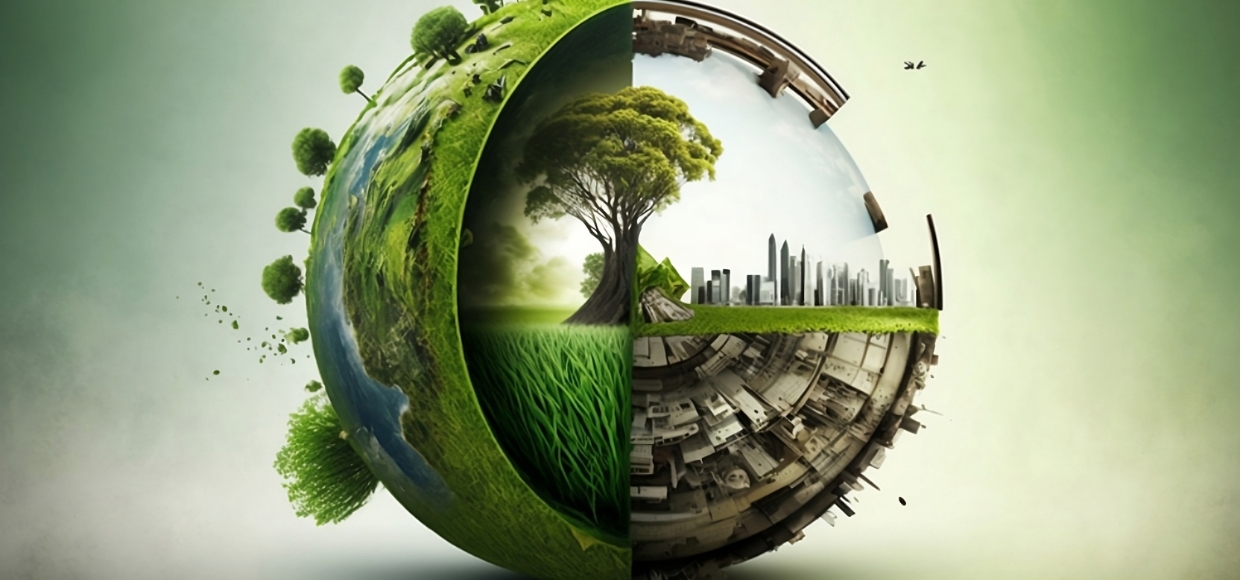
Don’t believe the hype: Making good use of a blackout
The Spanish blackout of April 2025 is an opportunity to strengthen electricity systems that have higher shares of renewables and should not be used as an excuse to slow down the energy...

by Adrian Dellecker Published May 22, 2024 in Sustainability • 8 min read
Despite global pledges and calls to action on both climate change and biodiversity, we are still evidently far from achieving sustainability. The World Meteorological Organization (WMO) has recently estimated that there is a 66% probability that global temperatures will exceed 1.5°C compared to the pre-industrial average in the next five years, a key psychological barrier since it is an increase of 1.5°C degrees that decision-makers aspired to at the Paris UNFCCC COP in 2015. We are, in fact, on track to see an almost three-degree increase by 2100, a scenario that will cause disastrous and irreversible harm to all humanity. We are faced with the fifth mass extinction event, this time human-caused, with a possible million species at risk of being extinct in the upcoming decade if nothing is done. Plastic pollution has reached such an extent that we are on course to have more plastic than fish in the oceans by 2050.
One useful framework to map out these interconnected threats is the Planetary Boundaries. These scientifically defined thresholds represent the limits within which humanity can safely operate without causing severe disruptions to Earth’s systems. Of the nine defined, we are already breaching five, including the two “core” boundaries of climate change and biosphere integrity — and “the window is closing fast” to reverse these trends, says Johan Rockström, who led the development of the Planetary Boundaries. This is because exceeding various tipping points means some of this damage could soon be irreversible.
By one metric, businesses are already actively supporting environmental goals via the increased Environmental Social and Governance (ESG) and Corporate Sustainability Reporting (CSR). Today, sustainability reporting through ESG is at a record high, with 96% of S&P 500 companies providing sustainability reports in 2021, up from just one in five companies in 2011.
There is clearly something missing in the sustainability recipe. This is partly due to ESG’s own shortcomings, “being neither a good measurement tool nor an effective risk-management one,” according to The Economist. And it is hard for investors to work out what it means for asset prices.
Even if ESG worked out these kinks, ESG metrics are, in any event, only intended to assess one thing: financial materiality. That is, the financial risk that environmental, social, or governance issues pose to a company’s bottom line. While this might influence investors and lead to some environmentally driven risk management, it is not the same thing as embedding sustainability action in value chains.
For this to happen, companies must measure their impact on planetary boundaries or sustainability more generally. The European Union has been referring to “impact materiality” since 2019 and has recently enshrined it into law. Impact materiality is a fundamentally different concept than the financial materiality that ESG has been trying to quantify, and far fewer companies have been reporting on this. This is where future progress might be measured.
Target-setting is nothing new for business — and is even quite prevalent for climate mitigation. More than 1,100 companies have already signed up for science-based targets via the Science Based Targets Initiative (SBTi) launched in 2015, and McKinsey has found that 83% of Fortune Global 500 companies have climate-related targets.
Yet, if we take the planetary boundaries as a guide, companies cannot confine their target-setting to carbon. Climate change is only one of the planetary boundaries under threat. Crucially, companies must also measure their impact on at least the other “core boundary”: biodiversity. There, the data is much less encouraging: According to the same McKinsey study, while more than half (51%) of companies acknowledge biodiversity loss, only 5% have set quantified targets.
This is true not just for the sake of biodiversity, natural resources, and ecosystem services, which currently provide $40tn to the global economy, or more than half of the global GDP, but also because it makes no sense to tackle carbon emissions in isolation without considering things like deforestation, land use, pollution, or even species loss.

From ESG compliance to competitive advantage

Natural climate solutions, such as “conservation, restoration, and improved land management actions that increase carbon storage or avoid greenhouse gas emissions,” are relatively low-cost ways of providing almost a third of the climate mitigation needed to achieve the 1.5°C–2°C by 2030 target at the heart of the Paris Agreement target. Even wildlife contributes to carbon absorption and other valuable ecosystem services.
Take the great whale, for example. When a great whale dies and sinks to the bottom of an ocean, it sequesters 33 tons of CO2. However, throughout its life, the great whale also plays a critical role in creating phytoplankton, which populates the ocean and collectively absorbs 37 billion metric tons of CO2 annually, about 40% of all CO2 produced. This is four times more than the CO2 absorbed by the Amazon forest. Great whales have been reduced to only 3% of their original population. Increasing the great whale population would contribute to biodiversity goals and mitigate climate change. And this is also true of other species, such as the forest elephant. Targets based on the planetary boundaries can be mutually supportive.
What is more, achieving planetary boundary-based targets can be a profitable business. According to McKinsey, corporate action across 47 targeted levers could get the world back within the boundaries of forest cover loss, freshwater consumption, and nutrient pollution. Not only that, but action across a number of these levers can generate a massive return on investment: Focusing on just 12 that can potentially deliver a 45% reduction in nature loss can bring an annual benefit of $700bn, net of costs. This, for example, includes regenerative agriculture in which inputs to soil are minimized and food waste and plastic pollution are reduced.
To finally start reversing the trends of environmental loss and make economic development sustainable, businesses will have to move beyond reporting ESG-related financial materiality and start implementing target-setting based on the planetary boundaries. The planetary boundaries framework can help set mutually supportive and reinforcing targets rather than tackling one challenge — carbon — as a single issue.
Many tools and frameworks already exist to help with this target setting. At the international level, the three UN Conventions on Climate Change (UNFCCC), Biodiversity (UNCBD), and Desertification (UNCCD) each have specific targets. Those for biodiversity — agreed in 2021 as the Global Biodiversity framework — have 23 targets over four goal areas. These are in addition to the Sustainable Development Goals (SDGs), agreed in 2015. These can all provide aspirational and sectoral frameworks for businesses to contribute to and join in with global efforts.

“Businesses must develop specific and measurable targets that contribute to all the planetary boundaries.”
Framing targets based on a company’s context and industry is facilitated through existing and evolving sustainability standards. The International Sustainability Standards Board (ISSB) has embedded the widely used Sustainability Accounting Standards Board (SASB) standards across 77 industries — and not just across six environmental areas, but throughout social and other sustainability criteria.
More recently, the Science Based Targets Network (SBTN) has been developing a nature-focused target-setting standard based on the full set of planetary boundaries, building on the success and popularity of the SBTi’s previous target-setting for climate. The SBTN has developed its own AR3T framework (Avoid, Reduce, Restore, Regenerate, Transform) that offers guidelines for industry-specific impacts and is currently piloting this target-setting with companies.
Some forward-looking companies have already begun this transition. Since 2019, L’Oréal, for example, has developed over 15 targets across the planetary boundaries. Kering has a biodiversity strategy based both on the planetary boundaries and the SBTN’s AR3T framework.
These companies are at the vanguard of an upcoming trend, and their head-start will likely give them a competitive advantage in the future as others catch up, and consumers increasingly demand sustainable products, especially as younger, more engaged generations emerge.
On January 5, 2023, the European Union Corporate Sustainability Reporting Directive (CSRD) came into force. It requires 50,000 companies in Europe — and even some non-EU with significant sales in the region — to report on the impact their business is having on nature. The number of companies concerned with this law is set to increase with time.
If they have not already done so, those who want to be seen as truly forward-thinking must develop specific and measurable targets that contribute to all the planetary boundaries. Through target-setting, companies have an opportunity to move from minimizing damage to setting a visionary strategy that creates positive change for all of nature and society.

Senior Researcher and Writer at IMD
Adrian Dellecker is a political scientist, environmental advocacy expert and innovator. He previously worked as Head of Strategy and Development at the Luc Hoffmann Institute, and has driven and managed a large number of innovative projects and ventures for environmental conservation. He is passionate about helping conservation generate new revenue streams and new audiences to help reverse current trends, and build a future for his and all the world’s children to thrive on a healthy planet. Before joining the Luc Hoffmann Institute, Dellecker was Head of Policy and Advocacy in WWF International’s Global and Regional Policy Unit from 2008 to 2016.

10 hours ago • by Cédric Philibert in Sustainability
The Spanish blackout of April 2025 is an opportunity to strengthen electricity systems that have higher shares of renewables and should not be used as an excuse to slow down the energy...

July 7, 2025 • by Julia Binder, Esther Salvi in Sustainability
Lindström found that expanding its business to Asia required overcoming cultural barriers as much as building new services and infrastructure while adapting itself to local needs. ...

June 16, 2025 • by Núria Ibáñez-García in Sustainability
Driving change in a system where progress can be slow and regulation is tight isn’t easy. But for Núria Ibáñez-García, sustainable transformation starts with steady influence, applied from within. ...

June 9, 2025 • by Julia Binder, Esther Salvi in Sustainability
Dr. Kiri Trier, the beauty giant’s regional sustainability chief, explains her drive to change customer habits and make cutting waste, refilling, and recycling part of their daily bathroom routine....
Explore first person business intelligence from top minds curated for a global executive audience